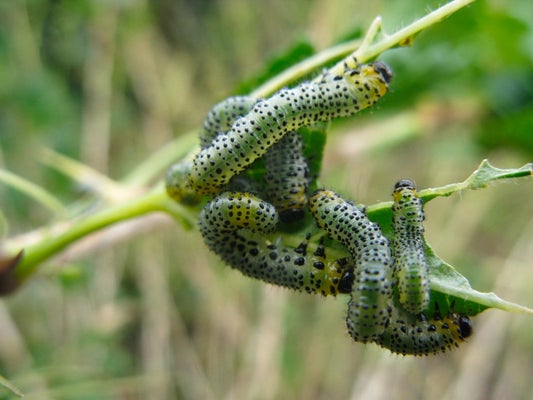
Quick facts
Common names - Common gooseberry sawfly, spotted gooseberry sawfly and small gooseberry sawfly
Scientific names - Euura ribesii, E. leucotrochus and Pristiphora appendiculata
Plants affected - Gooseberry, red and white currants
Main symptoms - Foliage is rapidly devoured by caterpillar-like larvae that are green with black dots
Most active - April to September
What is gooseberry sawfly?
Sawflies are a group of insects suborder (Symphyta) of the Hymenoptera (bees, ants and wasps). There are about 500 species of in Britain. They have caterpillar-like larvae that feed on plant material and are named after the saw-like egg laying organ used by females to lay eggs in plant material. Adults can come in a range of colours many are black, green orange or striped yellow and black. Most are small (< 1 cm) but some species such as the Birch sawfly (Cimbex femoratus) can be over 2 cm long. Several species can be found in gardens and are part of the a healthy garden will support. More information can be found at The Sawflies of Britain and Ireland webpages.
There are three common species of sawfly that can be found feeding on the leaves of gooseberry and some related fruit bushes.

Symptoms
Defoliation of the bushes can be caused by the caterpillar-like larvae of one of three species of :
- Common gooseberry sawfly (Euura ribesii) larvae are up to 20 mm long, pale green, with many black spots, and black heads. The adults are winged insects; females are 5-7 mm long and are yellow with black heads and black markings on the thorax; males are similar but more extensively marked with black, including the upper surface of the abdomen
- Pale spotted gooseberry sawfly (E. leucotrochus) larvae are slightly smaller than those of the common gooseberry sawfly and have pale green heads. It has one generation a year with larvae present in May and June. The adult is similar in appearance to the pale spotted gooseberry sawfly but are usually brown in colour
- Small gooseberry sawfly (Pristiphora appendiculata) can have up to four generations of pale green larvae from late April onwards. The adult, about 5 mm long, is black with pale yellow legs
- The larvae of some moths may also eat the foliage of gooseberries and currants
- Plants will usually survive complete defoliation, however this may reduce yield
Management
Sawflies are a part of the a healthy garden supports.
- Where possible tolerate populations of , complete defoliation rarely kills the plants although cropping may be affected
- Encourage predators and other natural enemies of sawfly in the garden, such as birds, wasps and ground beetles
- Check plants regularly from April for the presence of larvae to prevent a damaging population developing
- Remove by hand if required and where practical
- A biological control (pathogenic nematode), sold as Fruit and Vegetable Protection, can be watered on to plants with gooseberry sawfly. The nematodes enter the bodies of the sawfly larvae and infect them with a bacterial disease. This nematode is available from some garden centres or via mail order. The nematode should be applied during cool damp weather. Nematodes have the potential to infect non-target animals, they should therefore be used with care and only when there is a specific problem to treat
Downloads
Biological control suppliers (pdf document)
Biology
- The common gooseberry is the most frequently found of the gooseberry sawflies. It can have three generations a year, with the larvae active in late April to June, July, and August to September
- The female sawflies lay eggs on the underside of leaves, low down in the centre of the bush, so the young larvae go unnoticed until they have eaten their way upwards and outwards, devouring the leaves as they go
- Defoliated plants are weakened and may produce a poor crop the following year
- When the larvae are fully fed, they go into the soil, where they spin silk cocoons and pupate
- The pale spotted gooseberry sawfly only has one generation a year with larvae present in May and June
- The small gooseberry sawfly has up to four generations a year with larvae present from late April















